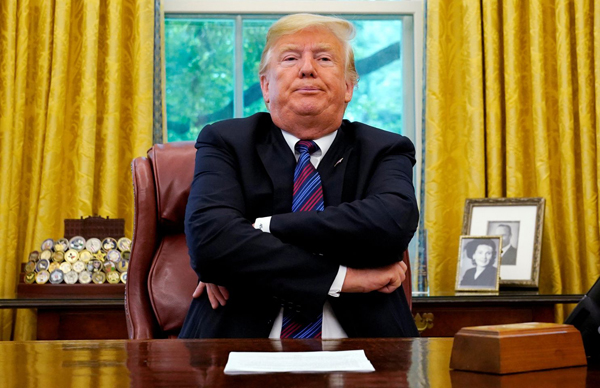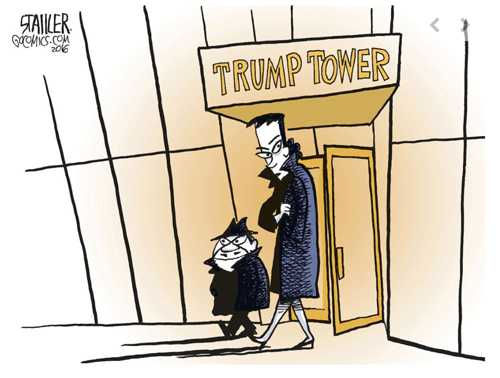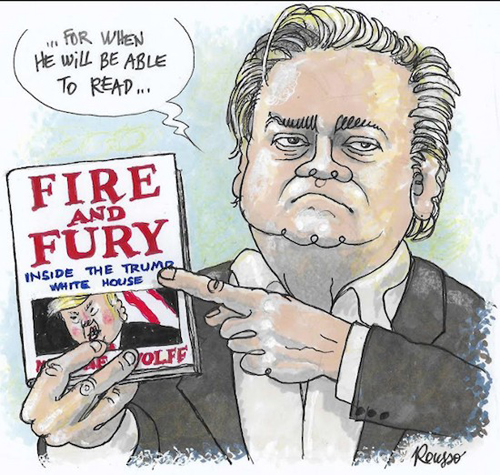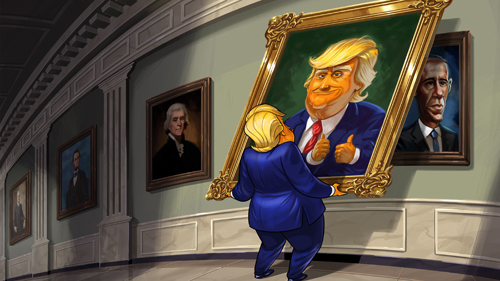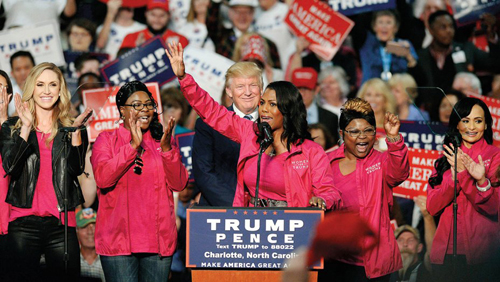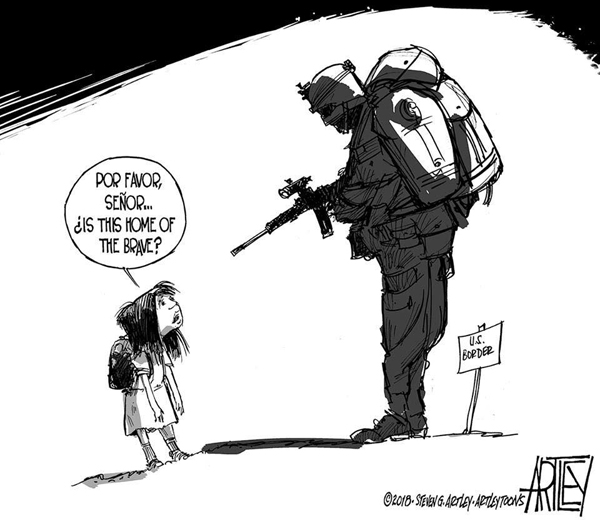DB here:
Ten years ago on this blogsite, I wrote about the emerging meme treating political races as a struggle among “competing narratives.” I decided to take the notion literally and applied some principles of narrative analysis to the 2008 campaign biographies of John McCain and Barack Obama. You can read the results here [2].
Four years later, I tried to do the same thing [3] with the Obama/Romney race. In both postings, I studied the candidates’ storytelling styles, their efforts at characterization, and the plot structures they presented. I didn’t try to repeat the effort in 2016, because the prospect of working through Trump’s Great Again: How to Fix Crippled America (2016) or Hillary Clinton’s Hard Choices (2014) seemed like eating sawdust.
But my sensitivity feelers are twitching again because this year we’re awash in more pop narratology. By now references to The Narrative or The Alternative Narrative have become taken for granted. (As in [4]: “Mr. Soros has been elevated by Mr. Trump and his allies to even greater prominence in the narrative they have constructed for the closing weeks of the 2018 midterm elections.”) What’s emerging is another notion swiped from the analyst’s toolkit: the Unreliable Narrator.
Wayne Booth, in The Rhetoric of Fiction [5] (1961) appears to have invented the term. It’s become very common; Google lists over 629,000 mentions. Its meaning seems self-evident, but it can still be misunderstood. Some writers seem to think that any first-person narrator is inherently unreliable. Everybody is biased, right? But Booth intended the term to refer to narrators, first-person or not, that cunningly mislead us through such tactics as ellipsis, equivocation, faulty judgment, and outright lying. In film we encounter unreliable narration very often, as in the opening of Mildred Pierce (1945) [6] or the initial voice-over in Confidence (2003) [7].
Booth and the critics who followed him have shown the idea to be a useful tool of literary analysis. And now it’s become politicized. An NPR opinion piece is called “President Donald Trump, Unreliable Narrator” [8] and compares Trump’s Twitter feed to the deluded and deceitful narration of Nabokov’s Pale Fire.
The issue of unreliability has come to the fore in three of the biggest-selling accounts of our monstrous presidential regime: Bob Woodward’s Fear: Trump in the White House [9], Michael Wolff’s Fire and Fury: Inside the Trump White House [10], and Omarosa Manigault Newman’s Unhinged: An Insider’s Account of the Trump White House [11].
I’ll consider them as narratives, while warning you, as before, that I’m not very concerned with tracking down their factual accuracy. That’s an important task, but I want simply to study what Booth might call the rhetoric of nonfiction. By looking at each book’s plot structure (yes, they have plots) and narration, I want to understand how narrative analysis can help us better understand what counts as “reliability.” Fortunately for my purposes, the books nicely illustrate three different models of storytelling.
Truth’s gold standard: Washington’s Recording Angel
Many mainstream reviewers seem to have assumed that Woodward’s book wins the reliability award. The Washington Post review [13], written by a member of Harvard’s English department, notes:
His utter devotion to “just the facts” digging and his compulsively thorough interviews, preserved on tape for this book, make him a reliable narrator. In an age of “alternative facts” and corrosive tweets about “fake news,” Woodward is truth’s gold standard.
What makes Woodward seem so reliable? Partly it’s his research method. Publicly available sources and on-the-record interviews are cited in endnotes, but the real meat comes from “deep background,” an arrangement in which the subject willingly supplies information with the promise that she or he will not be identified. We trust that what Woodward tells us is based on what his sources told him, although of course we then have to trust what they said.
This aspect of reliability requires us to accept Woodward-the-narrator as a figure of scrupulous probity. He does everything he can to sustain this sense. He doesn’t even rely on his memory to report what he said on television.
Two days before the election, November 6, I appeared on Fox News Sunday with Chris Wallace. The discussion turned to the possibility that Trump could win.
According to the transcript, I said on the show….(44).
This appeal to personal trust is enhanced by a ruthless simplicity of style. Woodward writes short sentences, short paragraphs, and short chapters. The gray, graceless prose, adorned with times and dates like a Dragnet episode, seems to guarantee neutrality. Here are two complete paragraphs.
At about 9 p.m. Monday, November 27, more than four months after Priebus left the White House, the president reached him on his cell phone. They talked for 10 minutes (287).
In a meeting in January 2018, Navarro, Ross, Cohn and Porter gathered in the Oval Office. After months of arguing about tariffs from entrenched positions, debates had become heated and sharp (334).
My Word for Mac program lists these passages as readable at the 8.8 grade level. This is narrative transparency par excellence, flat and factual and a little clichéd (entrenched positions, heated debates). The irrelevant realistic detail (a conversation lasts 10 minutes, not 9 or 11) adds to the sense of verisimilitude. Even venturing into mental terrain is done guardedly.
Trump seemed not to remember his own decision because he did not ask about it. He had no list–in his mind or anywhere else–of tasks to complete (233).
Trump seems, to an unknown observer, to forget his decisions. The following claim about his list-less mind becomes not a plunge into his psyche but a commonsense inference based on his work habits.
Woodward enhances trust by building the story out of scores of conversation scenes. Each of the 42 chapters consists of several incidents, presented with minimal intervention by the narrating voice. It’s as if a tape recorder is playing history back for us.
This strategy can produce powerful scenes. I won’t soon forget the lengthy efforts of John Dowd, Trump’s attorney, to rehearse his client testifying before Mueller. Over four pages, Trump reveals himself incapable of sticking to the point or telling the truth. In desperation (“Don’t testify. It’s either that or an orange jump suit”), Dowd goes to Bob Mueller and instructs his colleague Jay Sekulow to reenact highlights of the president™’s audition. After Sekulow executes a torrent of rambling, contradictory replies (“a perfect Trump”), Dowd brays, “Gotcha!” and explains that his client obviously can’t be dragged in. This Brechtian skit leaves Mueller largely unmoved.
Occasionally the objective surface is broken by the thoughts of selected participants. When this happens, Woodward’s reported conversations flow along like a pulp novel or a sitcom screenplay. Steve Bannon calls on Paul Manafort in Trump Tower.
Manafort’s place was beautiful. Kathleen Manafort, his wife, an attorney who was in her 60s but looked to Bannon like she was in her 40s, was wearing white and lounging like Joan Collins, the actress from the show Dynasty. . . .
[Manafort shows Bannon a draft of a New York Times story.]
“Twelve million fucking dollars in cash out of the Ukraine!” Bannon virtually shouted.
“What?” Mrs. Manfort said, bolting upright.
“Nothing, honey,” Manafort said. “Nothing.”
“When is this coming out?” Bannon asked.
“It may go up tonight.”
“Does Trump know anything about this?”
Manafort said no.
“How long have you known about this?”
Two months, Manafort said, when the Times started investigating.
Bannon read about 10 paragraphs in. It was a kill shot. It was over for Manafort (21).
This works by creating a POV character. It’s not Woodward but Bannon, ex-Hollywood bottom-feeder, who seems to be making the Joan Collins connection while talking/thinking like a second-tier hitman in Get Shorty.
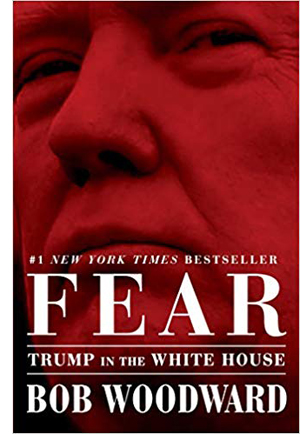 [14]Still, turbocharging other encounters in this way might seem a risky strategy. How is the reporter to gain our credence? How is he able to produce for our delectation pages of exact dialogue? Who remembers conversations so exactly? And how has Woodward reconciled the witnesses’ different recollections? “Deep background” supplies the material, but how much has Washington’s Recording Angel shaped the disparate stories he’s heard?
[14]Still, turbocharging other encounters in this way might seem a risky strategy. How is the reporter to gain our credence? How is he able to produce for our delectation pages of exact dialogue? Who remembers conversations so exactly? And how has Woodward reconciled the witnesses’ different recollections? “Deep background” supplies the material, but how much has Washington’s Recording Angel shaped the disparate stories he’s heard?
Henry James, reacting against the loquacious authorial-voice narrators of Dickens and Thackeray, argued that the novelist could learn from the playwright. A play doesn’t include a chatty narrator; the characters are on their own. “Dramatize it, dramatize it!” Roll out the novel’s action in “discriminated occasions,” concrete scenes that reveal the characters’ traits and desires through behavior–gestures, looks, speech. This presentation is subtler and more realistic than a commenting narrator’s explications. The reader has to work a little more to judge what she sees and hears, just as we do in real life. And there’s more artistry in implying the undercurrent of motives than in letting a godlike narrator state them baldly.
The admonition to dramatize went along with another Jamesian premise, that of limited viewpoint. Restrict what the reader knows to a “center of consciousness,” a single intelligence who registers the action played out. That viewpoint might be sustained for an entire story or novel, or it might be confined to a single chapter, with another chapter taking up another character’s perspective. Again, realism is enhanced (this is how we see the world, through a single mind), but so is artistry. There’s a skill to arranging your plot so as to let its implications register gradually on a character. (Especially when, as in “In the Cage” or What Maisie Knew, there are severe limits on the character’s knowledge.) Now the story would be about how characters try to understand and judge situations, and how their inferences shape their reactions.
James’s ideas were developed and formularized in Percy Lubbock’s The Craft of Fiction [15] (1921), and they became commonplace in modern writing. We are so used to them that going back to read the classic nineteenth-century novels brings us up short: long paragraphs of authorial commentary can seem forbidding. Elmore Leonard’s laconic crime sagas epitomize the modern taste: “Try to leave out the parts that readers tend to skip.” [16]
Bob Woodward is no James or Dutch Leonard, but he builds Fear out of “discriminated occasions” presented as dramatic clashes among characters. He also occasionally filters those scenes through the reactions of participants, as in the Bannon scene above. By following broad mandates of twentieth-century literary technique, Woodward gains the reliability of a unified fiction.
As in a novel, readers of Fear tap into several minds–not just Bannon’s and Dowd’s, as above, but those of other major players like Gary Cohn, Reince Priebus, James Clapper, and Rob Porter. The arc of the book, most of which covers the period from August 2016 to March 2018, surveys their activities planning policy and responding to Trump’s mischief and Mueller’s investigation. There seems little doubt that these gentlemen, all eventual exiles from the Trump White House, were the prime sources of Woodward’s narrative. As if in payback, our author breaks the impersonal surface to offer a mildly approving comment about them.
At the very start, amid a lump of exposition, Gary Cohn’s impressive credentials and bold initiative are spotlighted.
In early September 2017, in the eighth month of the Trump presidency, Gary Cohn, the former president of Goldman Sachs and the president’s top economic adviser in the White House, moved cautiously toward the Resolute Desk in the Oval Office (xvii).
Cohn is swiping a disastrous letter that would terminate a free-trade agreement with South Korea. By burying it in a file, he keeps the chief executive from signing it, and Cohn trusts (correctly) that his boss will just forget. “I stole it off his desk,” he explains. “. . . . Got to protect the country.”
Cohn’s surreptitious heroism is abetted by Rob Porter, staff secretary and Trump gatekeeper. This “6-foot-4, rail-thin” Mormon “ordinarily tried to remain an honest broker who facilitated the discussion” (335). Porter weaves through the narrative, and we get his muted reactions to meetings. A scandal thrusts him out the door, but Woodward treats the alleged wife-beater with bland gentility.
Porter quickly concluded it would be best for all–his former spouses, his family and close friends, the White House and himself–to resign. He wanted to focus on repairing relationships and healing (336).
Woodward inserts this into a studiously tame account of the allegations and Porter’s public reply, but there is a difference between writing this passage and writing: “He said he wanted to focus on…” Woodward’s phrasing tacitly aligns us with Porter. And who can condemn someone who likes “relationships and healing”?
Woodward is sometimes characterized as working in the space between journalism and history. I suggest that his techniques are borrowed from fiction as well. He uses the tactics of post-Jamesian literary narrative to dramatize his plot, to attach us to privileged centers of consciousness, and to secure our trust. Fear reads like a summer beach page-turner because, in its construction, it is.
Exaggerating the exaggerations
Cagle Cartoons, via The Brooklyn Eagle [18].
Michael Wolff, by contrast, is untrustworthy, according to many reviews. This one in The Atlantic [19] is widely quoted online, perhaps because its author is Adam Kirsch, himself a novelist.
If Michael Wolff is writing fiction in Fire and Fury, this is the kind of fiction he is writing. Indeed, at the very beginning of the book, in an author’s note, Wolff declares himself an unreliable narrator: “Many of the accounts of what has happened in the Trump White House are in conflict with one another; many, in Trumpian fashion, are baldly untrue. Those conflicts, and that looseness with the truth, if not with reality itself, are an elemental thread of the book,” he writes. The traditional promise of the journalist is to find the single, fundamental truth obscured by all the partial, biased accounts he elicits. But Wolff explicitly declines to make that promise; he offers not the story but a whole chorus of stories.
But in the passage quoted, Wolff doesn’t actually claim to be unreliable. He isn’t asserting that his book is endlessly juggling incompatible accounts. Kirsch neglects to quote the sentences that follow the passage he picked out:
Sometimes I have let the players offer their versions, in turn allowing the reader to judge them. In other instances I have, through a consistency in accounts and through sources I have come to trust, settled on a version of events I believe to be true (xii).
So no less than Woodward, Wolff is committed to finding out the truth. But he admits, as Woodward never does, that constructing an accurate account, in the face of disparities and incomplete information, can’t always be done. Some conclusions can be fairly well-founded, while others must be tentative and still others must be suspended. For example, Wolff borrows from Franklin Foer a set of possible reasons that Trump cozies up to Putin. Wolff offers what evidence he can for each hypothesis, but doesn’t rule any out, and he suggests that many may be at work at the same time.
In sum, Woodward’s story world is transparent, Wolff’s intermittently opaque, but both grant that there’s something out there to be seen. This isn’t what Kirsch calls “a perfectly Postmodern White House book.” More like Citizen Kane or The Thin Blue Line, I guess, than Last Year at Marienbad.
Just as Woodward’s narrative relies on our trust in him as the ultimate fair-minded chronicler, Wolff trades on his reputation as a somewhat sensationalistic media commentator. The author of a scathing biography of Rupert Murdoch [20], he’s often spoken of as a “columnist” rather than a journalist–a slight I take as a way of dismissing him. But he explains that he got access to this shambolic White House in a way that the orthodox press couldn’t. He just walked in and sat around and drifted into offices to listen to what people said.
Wolff claims, as Woodward does, to have nabbed these leakers’ comments on tape. So those who valorize Woodward’s meticulous recording ought to equally prize Wolff’s efforts. I expect, though, that Wolff’s reputation and his more gonzo enterprise cast doubt on his reporting. Yet despite a few minor errors of fact widely reported in the reviews, nobody has to my knowledge shown fatal shortcomings in Wolff’s account. It corresponds closely to that of Woodward, and it shows a degree of skepticism, analysis, and brutal humor which the the staid Woodward never displays.
Wolff’s time span is tighter than Woodward’s, running from Election Day (8 November 2016) through August 2017, with an epilogue in October. Woodward’s episodic vignettes trace White House activities chronologically and topically; chapters are devoted to Russian hacking, Middle Eastern initiatives, tariffs, and the like. Although the chapters are untitled, you can practically see the labels on Woodward’s file drawers. Fire and Fury works in larger chunks: half the number of chapters, tagged with titles indicating either a specific time frame (the transition, “Day One”) or a topic or, in many cases, a player (“McMaster and Scaramucci”).
If Woodward’s book is largely about Trump as viewed by a cluster of hirelings assigned to damage control, Fire and Fury is about the struggle of Steve Bannon to make Trump act on his white supremacist, institution-wrecking impulses. Wolff’s story is about how a chief executive of no principles except selfish advantage lurches from one view or action or statement to another, depending on who influences him at the moment. Bannon steers him with the help of ad hoc allies (Reince Priebus, Katie Walsh), while Jared Kushner and Ivanka (named by Bannon “Jarvanka”) press him in another direction. It’s a zero-sum game, with fluctuating results. Bannon beats Ivanka on the Paris accords (“Score. The bitch is dead”), but he loses when Trump turns against Bannon’s ally Jeff Sessions. In this Jacobean, shiv-in-the-ribs milieu, eventually Bannon loses. Banished to Breitbart Central, he hopes to continue the Trump Revolution.
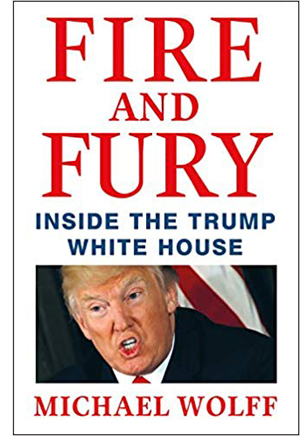 [21]Figures who are center stage in Fear (Mattis, McMaster) are lucky to get walk-on roles in Wolff’s book. Woodward’s savior of the republic Gary Cohn is mentioned by Wolff only three times, and then as malleable clay brought on by the Jarvanka faction. (Bannon loyalist Sam Nunberg: “I beat the shit out of Gary whenever possible,” 144.) Cohn’s sidekick Rob Porter makes no appearance at all.
[21]Figures who are center stage in Fear (Mattis, McMaster) are lucky to get walk-on roles in Wolff’s book. Woodward’s savior of the republic Gary Cohn is mentioned by Wolff only three times, and then as malleable clay brought on by the Jarvanka faction. (Bannon loyalist Sam Nunberg: “I beat the shit out of Gary whenever possible,” 144.) Cohn’s sidekick Rob Porter makes no appearance at all.
Call it Bannon-centric, but this book has a plot spine lacking in Woodward’s calmly appalled cavalcade of follies and indignities. Just as important, Wolff takes a notably different narrating approach. Nowhere in the book do we find passages like the back-and-forth between Bannon and Manafort. We get something more dense: the voice of a commentator scanning a range of events and extracting their gist, usually for purposes of mockery. Try this:
Intoxicated by Trump’s flattery during the campaign, Flynn–a lower-tier general and quite a flaky one at that–had become something of a Trump dancing monkey. When former generals make alliances with political candidates, they customarily position themselves as providers of expertise and figures of a special maturity. But Flynn had become quite a maniacal partisan, part of the Trump traveling road show, one of the ranters and ravers opening Trump rallies. This all-in enthusiasm and loyalty had helped win him access to Trump’s ear, into which he poured his anti-intelligence-community theories.
During the early part of the transition, when Bannon and Kushner had seemed joined at the hip, this was part of their bond: an effort to disintermediate Flynn and his often problematic message. A subtext in the White House estimation of Flynn, slyly insinuated by Bannon, was that Defense Secretary Mattis was a four-star general and Flynn but a three-star.
“I like Flynn, he reminds me of my uncles,” said Bannon. “But that’s the problem: he reminds me of my uncles (103).”
The comedy here (at a 12th-grade reading level) is wholly typical of the book as a whole, but I want to consider how Wolff deploys two classic narrational strategies. First, instead of scenes, he supplies what Gérard Genette calls summaries: concise overviews of action. In the passage above we get a summary of Flynn’s antics on the campaign trail, then a summary of many (untold) incidents of Flynn’s efforts to woo Trump, a summary of the tactics Kushner and Bannon employed to keep him at a distance, and a summary of Bannon’s initiative to lower esteem for Flynn. The whole is buttoned up by a zinger from Bannon, a discriminated occasion but hardly a scene.
The second narrational strategy at work here is what literary critics tend to call omniscient narration. This voice knows all the backstairs gossip. It knows what went on in Flynn’s mind (he was flattered by Trump), how he behaved at rallies, how he tried to sway Trump, what went on between Kushner and Bannon, and what Bannon’s scheme was. Granted, Woodward roams widely in his book, across many encounters and agents, but as he shifts the moving spotlight, he never offers this panoramic blend of different points of view and commentary. Nor would he venture Wolff’s judgments (dancing monkey, flaky general, ranters and ravers, Bannon’s slyness). Wolff’s viewpoint is unrestricted and it plunges deep into characters’ psyches.
I suspect that this combination of summary and omniscience has made Wolff seem less reliable to orthodox reviewers. Woodward’s “just the facts” approach, while no less carefully sculpted, allows the reader to feel smart: we appear to get to draw our own conclusions. Wolff’s evidence is packaged, wrapped, and tied in a bow. But that doesn’t make him unreliable. We can verify a lot he lays out in the passage. Flynn did criticize the intelligence establishment, he did misbehave at Trump rallies (“Lock her up!”), and he did eventually get sidelined, before being snagged by Mueller and hustled toward a guilty plea. And we have no reason to doubt that Kushner and Bannon, momentary allies, tried to sideline him.
In fiction, this is an old-fashioned way to write. It harks back to the nineteenth-century commentative author that the James-Lubbock orthodoxy found pushy and unsubtle. Like Dickens or Thackeray, Wolff tells us how to feel and what it all means. But this is not necessarily an inferior strategy. It allows Wolff to interpret the action to a degree that Woodward shrinks from. In one of many shrewd passages, Wolff notes the very choppiness that Trump forces Woodward into, the fusillade of outrages that exhausts pundits and citizens of conscience.
But before moving on to the next episode of ohmygodness, it is worth considering the possibility that this constant, daily, often more than once-a-day pileup of events–each one canceling out the one before–is the true aberration and novelty at the heart of the Trump presidency.
Perhaps never before in history…have real-life events unfolded with such emotional and plot-thickening impact. In the fashion of binge-watching a television show, one’s real life became quite secondary to the public drama. It was not unreasonable to say Whoa, wait just a minute: public life doesn’t happen like this. . . . Contravening all cultural and media logic, Donald Trump produced on a daily basis an astonishing, can’t-stop-following-it narrative (250-251).
I think Wolff’s observation, hyperbolic as it is, rings true. During the Vietnam War years or the Watergate hearings, there wasn’t the pounding cascade of twists and jolts. I recall that during the 2016 campaign, an especially salubrious Trump consultant said in an interview that they aimed to win each day’s news cycle. Now, day by day, Trump has managed to elicit a paradoxical reaction: You’re always stunned but never surprised.
Perhaps it takes a media writer to notice this phenomenon, but it remains a level of essayistic reflection that one searches for in vain in Fear. Yet passages like this make many think Wolff is unreliable. Actually, he’s just opinionated. Fear is the story above the fold, Fire and Fury is the no-holds-barred op-ed. And it’s no less “novelistic,” though in a different fashion.
Finally, Wolff’s writing style would make nervous critics worry about reliability. He makes serious points with sarcasm, and I think that this blend comes off as Not Real Journalism to those who find his narration unreliable. I didn’t laugh once in reading Woodward’s book, except when he quoted Trump, but Wolff’s cynical wit is quite fetching. He calls Stephen Miller “a fifty-five-year-old trapped in a thirty-two-year-old’s body” (62). (It’s the fifty-five that makes it art.) The three-pole White House power center (Bannon, Kushner, Priebus) is “a 1970s video game, the white ball pinging back and forth in the black triangle” (117). No guess on who’s the white ball. Questioning Jeff Sessions, Al Franken “appeared to be casting blindly for an elusive fish” (151). And Trump and Hope Hicks court NYT journalist Maggie Haberman assiduously.
Haberman’s front-page beat at the paper, which might be called the “weirdness of Donald Trump” beat, involved producing vivid tales of eccentricities, questionable behavior, and shit the president says, told in a knowing, deadpan style. Beyond acknowledging that Trump was a boy from Queens yet in awe of the Times, nobody in the West Wing could explain why he and Hicks would so often turn to Haberman for what would so reliably be a mocking and hurtful portrayal (206-207).
Still, Wolff’s caustic byplay can’t match the Trump original. My favorite is Trump’s complaint about the media: “They take everything I’ve ever said and exaggerate it. It’s all exaggerated. My exaggerations are exaggerated” (98).
As if anticipating my comparison with Fear, Wolff cannily sets his book against the standard norm of White House reportage. Noting Bannon’s reverence for David Halberstam’s 1972 book The Best and the Brightest, Wolff argues that it became the template for high-tone coverage of national politics. Its chief heir is Bob Woodward, “a figure of unchallengeable presidential mythmaking” (54). Fire and Fury is deliberately the anti-Woodward Trump book. In a spirit of meta-mischief Wolff can even invoke the topic of today’s sermonette. He remarks that Trump and the mainstream media have created “two unreliable narrators dominating American public life” (38). For some of us, Wolff’s ironic acknowledgment of unreliable narrators can only enhance his reliability.
Omarosa Agonistes
Whatever doubts reviewers have about Wolff’s book, Unhinged: An Insider’s Account of the Trump White House struck a deeper nerve. “This is what complicity looks like,” says a Mashable reviewer [23]. The Columbia Journalism Review [24]declares that Omarosa is “an unreliable narrator” because Frank Luntz and George Conway have denied quotations she attributed to them–not exactly the most corrosive counterevidence you might consider.
For these observers, what makes the author’s account doubtful largely depends on her reputation. Omarosa’s public image from the Apprentice TV show has been that of the villainness, and her willingness to work for Trump’s campaign and regime has made her seem compromised. Some remarks, notably the one predicting that all will have to “bow down” to her boss, the most powerful man in the universe [25] (not mentioned in the book), have made her seem both ruthless and unhinged herself. More than one reviewer has declared that she learned aggressive self-promotion from the master, with the book becoming a plausible cash grab after she has been sacked.
Yet this problem would arise with any Trump confidant who broke with the master and decided to tell all. Trump has inoculated himself by assembling such a band of miscreants that any confessional book would be lambasted as the work of an opportunistic grifter. Should Stephen Miller or Sarah Huckabee Sanders be bounced from the team, find enlightenment on the road to Damascus, and publish critical memoirs, Trumpists would call them traitors, anti-Trumpists would call them fellow travelers, and everybody would call them opportunists. I’d wecome Allen Weisselberg [26] turning apostate and telling us how the Trump organization has made its money, but he too would surely be castigated for years of complicity.
As with any such tell-all, the difficulties are compounded by a narrative technique that’s different from Woodward’s moving-spotlight survey and Wolff’s synthesizing summaries of cloak and dagger. Omarosa is obliged to tell her tale in the first person, so information is restricted to what she witnesses or hears from others. The advantage is that she becomes a more direct source than Woodward or Wolff; indeed, she might have been one of their “deep-background” sources. Had she not had the reputation of a cunning vixen, what she tells might prove more damning than anything the two men retail at second hand.
Yet for a moment let’s suspend Omarosa’s public image. Omarosa the writer (and her ghost collaborator, thanked in the acknowledgments) are flesh and blood. Omarosa the narrator of Unhinged is somewhat distinct: an image constructed for the sake of telling this story. Just as Woodward the reporter might be a closet Republican and Wolff might be a mercenary gossip, their narrative personas might still be trustworthy. Ms. Manigault Newman off the page might be a conniver, but Omarosa the narrator might be reliable. Maybe her story isn’t a con job.
Given that her reader knows her reputation, her first task is to earn trust. One way is to report things that we know to be true or will take to be plausible. Surprisingly, a lot of Unhinged consists of Trump’s public statements. What’s news in these instances are the reactions of those in the White House to the cascade of insults, lies, and blunders. And those reactions are no more implausible than the behind-the-scenes dramas reported by Woodward and Wolff. Details matter too. Everyone will recognize the book’s glancing account of Trump’s gestures, “the ‘cobra’ pointed finger and the starfish finger flail” (269).
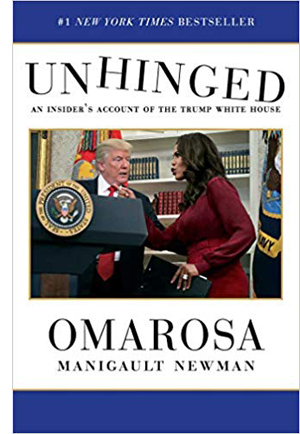 [27]Other items are in keeping with everything else coming out of the regime. It’s unfortunately plausible that Trump called Conway, who has Filipino heritage, a FLIP (Fucking Little Island People), or that Trump claims that the birther calumny was legitimate “opposition research” (260, 52). It’s wholly in character that Trump would use his leverage to keep Omarosa from suing his ally the National Inquirer over a distorted story about her brother’s death (55-57). The book makes nasty remarks about the vacuity of the Trump offspring and Kellyanne Conway’s predatory opportunism (having switched from supporting Cruz to supporting Trump). But these too don’t contradict well-established impressions from other sources. Even the claim that Omarosa saw Trump eat a document isn’t far-fetched to me. We’ve learned that he tears up papers that aides must tape back together to preserve presidential records, and he likes to eat.
[27]Other items are in keeping with everything else coming out of the regime. It’s unfortunately plausible that Trump called Conway, who has Filipino heritage, a FLIP (Fucking Little Island People), or that Trump claims that the birther calumny was legitimate “opposition research” (260, 52). It’s wholly in character that Trump would use his leverage to keep Omarosa from suing his ally the National Inquirer over a distorted story about her brother’s death (55-57). The book makes nasty remarks about the vacuity of the Trump offspring and Kellyanne Conway’s predatory opportunism (having switched from supporting Cruz to supporting Trump). But these too don’t contradict well-established impressions from other sources. Even the claim that Omarosa saw Trump eat a document isn’t far-fetched to me. We’ve learned that he tears up papers that aides must tape back together to preserve presidential records, and he likes to eat.
Central to Omarosa’s thesis, and giving the book its title, is the claim that Trump is undergoing mental decline. Having known him since 2003, Omarosa claims that he was once a quick-witted calculator and a less rambling conversationalist. His admission that he fired Comey because of the Russian investigation convinces her there’s deterioration.
But what could I do? Declare a state of mental emergency for Donald J. Trump? Should I report this insight to . . . to whom, exactly? The White House doctor Ronny Jackson, whose job depended on Trump’s approval of him, a man who would go on to declare an obviously obese, sleep-deprived man in excellent health? To the chief of staff [Priebus], a man I didn’t trust or respect? To Don, Jr., Ivanka, or Eric, who had to be seeing what I saw, and had done nothing? To Melania? She was completely trapped herself. And what would I say? “I’m not a doctor, but I think the president is losing it.”. . . .
[She contacts Eric’s wife Lara.]
When she came by in a week or so, I said, “I’m really concerned about him.”
She said, “I know. The whole situation is totally messed up.”
“No, I mean his language is incoherent. This is more than just a–“
“No,” she said, like she didn’t want to hear it.
“I think he needs to get checked.”
She shook her head and said, “It’s fine.” . . . .
I would eventually talk to several high-level people in the White House about my concerns, and they all shut me down quickly and decisively, with warnings (246-247).
Again, these episodes (mixtures of scenes and summaries) don’t seem implausible. Maybe Omarosa’s wrong, and Trump isn’t going gaga, but it’s not utterly far-fetched. She entertained the possibility. She’s not alone.
As for reporting White House activities, Omarosa seems to rely on both diary notes–some chapters are given in day-by-day chronology–and tape recordings. The big difference between her tapes and those that Woodward and Wolff draw on is that she has played a few for a skeptical press. Two passages of the book’s dialogue–her firing at the hands of General Kelly, and Lara’s offer of a $15,000 monthly stipend–are confirmed by recordings. (The very fact that she was able to tape so much supports her general picture of a chaotic administration.) She has also released a tape of Trump phoning her and claiming he was unaware of her firing, as recounted in the book. And Washington Post staff may have heard still others [28] that support passages in Unhinged.
After the book was published, Omarosa claimed to have a great many tapes. Maybe she has a recording of the mental-health discussion with Lara.
In constructing her narrating persona, then, Omarosa has offered known claims, plausible claims, and a measure of hard evidence. If she weren’t notorious for scheming, that persona might have won over skeptical readers. But of course she’s considered a schemer, so she needs another way to earn our trust. She does it by offering a plot centered on conversion and redemption.
The protagonist of Unhinged suffers a childhood of food-stamp poverty in the decaying Youngstown projects. Her cousin dies in an apartment fire, her father at the hands of an assailant. She pulls herself out of it through beauty pageants and raging ambition, finishing college and going into politics. A staffer for Al Gore, she goes on to work in the Clinton White House. But she is angered by the Clintons’ failure to connect with black groups, and especially by the scandalous treatment of women during Lewinskygate. After a stint with CNN and the DNC, she joins the cast of The Apprentice and meets The Donald.
Omarosa the narrator has to finesse many matters in her telling, but race is central. She traces an oscillating arc. In the early years, she never heard Trump utter a racist word. He was, in a piece of hair-splitting, “racial” in using race to divide people and achieve his ends, but not strictly “racist”–at least not until he embraced birtherism. She prevaricated about Trump’s plot to “destroy” Obama, but decided that her work life mattered more. “If your boss expressed political views that differed from yours, would you protest and quit your job? I reasoned he had a right to his opinion, just as I had a right to mine” (46-47). Not least, Trump treated her very well; she considered him a friend.
The story starts to shift in recent years. A lot of what she sees is disquieting–the Access Hollywood Tape, Trump’s refusal to learn about racism and sexism, his apparent mental decline. She tries to push initiatives to help minority communities, but black leaders mostly shun and lambaste her. Within the White House, she fights other appointees–“tackled by her teammates.” But the pluses outweigh the minuses. Caught up in Trumpworld, she knows success and a sense of accomplishment. She admits enjoying the perks and prestige. She blocks out what everyone else sees. “It was difficult to process the anxiety and pain others were suffering as a result of the administration” (324).
The breaking point comes in August of 2017.
Until Charlottesville, I couldn’t allow myself to process how bad things had become, because that would mean confronting things I’d noticed and ignored about Trump all along. My blind spot was shattered during that press conference, though. I could see with my own eyes that Trump had no idea what people were so upset about. He just did not grasp it. He was disconnected from reality. . . .
He moved like he was being attacked. A young woman was dead, and he was only thinking about his own discomfort.
He said, “How about a couple of infrastructure questions?” . . . .
During this incredible unraveling, Trump also trashed John McCain for voting against his health care bill, called reporters fake news, pointed out that George Washington and Thomas Jefferson were slave owners, questioned the validity of removing racist symbols like Confederate statues, defended the white supremacists and neo-Nazis for having the proper permits (they didn’t, actually), made a dig at Obama for not fixing race during his eight years as president, and touted that he’d brought a car factory to Wisconsin. Trump’s mental decline was on full display during this press conference (286).
All this precedes the most “incendiary” remark of all, the claim about “very fine people, on both sides” (289). After this, Omarosa plans her strategic exit. Her distinction between racial and racist “was a deception I had used to convince myself” (292). Either Trump wants to start a race war or has simply lost all judgment. Either way, she needs to get out of Trumpworld.
She waited, she explains, because she had a conference scheduled for student representatives of historically black colleges and universities. She claims to have resisted efforts by others to halt the conference; one official fears that after Charlottesville “they might riot. They might burn the place down” (302) After the conference is held without incident, Omarosa settles on a January departure, to accord with tradition and to allow Trump to find another person to handle African American outreach. But then, amid many other crises, she starts to hear about a damaging Apprentice tape. She starts to investigate it, only to be fired in December by Chief of Staff General Kelly.
All of the books I’m considering have what I call in Reinventing Hollywood a “crisis” structure. The text begins at a major moment in the story and then flashes back to trace how events led up to it. In Fear, it’s the moment when Gary Cohn pulls the South Korean letter off Trump’s desk; Woodward wants us to ask: How on earth did things come to this pass? In Fire and Fury, the prologue (“Ailes and Bannon”) is a dinner between Roger Ailes and Steve Bannon after the election. This establishes Wolff’s major theme of Bannon becoming the new right-wing power broker, with the pattern rounded off by the epilogue (“Bannon and Ailes”).
For Unhinged, the crisis-driven Prologue is Omarosa’s firing by Kelly. It benefits from the first-person narrative because it creates both mystery and suspense, thanks to inner monologue:
“There are serious integrity violations,” he said.
Why was he being so vague? What violations?
“The staff works for me, not the president. So after your departure, I’ll inform him. With that, I’ll let you go.”
What is he talking about? Where is this coming from?
Quickly, I connected the dots.
This had to be about the N-word tape (xi).
At the book’s end, we return to this scene and pass beyond it to Omarosa’s efforts to get out the truth about Trump.
Once again we have a narrator resorting to a novelistic technique, but this one carries special weight because it puts us directly inside a participant’s mind. Of course, she may be misreporting, as those deep-background sources sharing their thoughts with Wolff and Woodward might be. But first-person narration produces a vivid sense of actuality. (Dramatize, dramatize.) Add to this Omarosa’s later discovery, in the final pages of her memoir, of a person who confirms what Trump said on the tape. This proves to her that he was a racist way back when she first met him. She was fooled for many years.
After all this, Omarosa can devote her time to the mission of warning us about Trump and his administration. But ultimately she has found her true identity as a Baptist pastor and a loving wife. “I’ve escaped from the cult of Trumpworld. I’m free” (330). Going from rags to riches, learning the cost of those riches, the heroine, redeemed by suffering and now more aware of what she wants and the way the world is, has won. She too finds relationships and healing. If this were romance fiction, we’d call it a happy ending.
Unhinged is written at an eighth-grade reading level.
A narrative analysis like mine can’t guarantee the truth of what the story says. But it does point up factors in persuading us to trust it. I am not making the point–as you’ll sometimes see in caricatural portraits of Postmodernism–that all narratives are fictions. There is a fact of the matter, though usually we can’t determine it easily. Much of what Woodward, Wolff, and Omarosa write, often mutually reinforcing, will need to be confirmed independently.
Still, the way each writer has shaped and colored the material also plays a role in soliciting belief. More than we usually admit, those ways owe a great deal to the strategies of fictitious narratives. “Just the facts” isn’t enough. Our trust in the what is often dependent on the how.
P.S. 6 October 2019: For a careful analysis of what Woodward’s narrative leaves out, see this takedown [30] by, of all people, David Frum.
Incidentally, from the rush of recent events, including George Conway’s persuasive argument [31] that Trump is genuinely mad, it’s not noted that Omarosa was the first insider to float this possibility. Her invaluable book remains unfairly ignored.
Thanks to Deborah Blum [32] of The Knight Science Journalism Program at MIT for helping me clarify some conventions of reportage. She writes excellent books!
Henry James calls for dramatization in several of his writings. See the preface to “The Author of Beltraffio” and other tales in Literary Criticism: French Writers, Other European Writers, The Prefaces to the New York Edition (New York: Library of America, 1984), 1241 [33]. He goes on to say that “that provided for all my ‘fun’.” Only James puts “fun” in quotes. Gérard Genette’s distinction between scene and summary can be found in Narrative Discourse: An Essay in Method [34], trans. Jane E. Lewin (Cornell University Press, 1980), 94-99.
For Omarosa’s 2016 declaration of friendship with Donald, see here [35].
